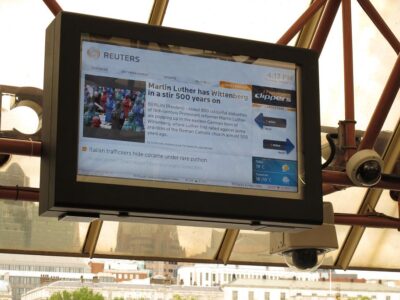Providing customers and the general public with information is a big challenge for many businesses and institutions, but also an essential one. For businesses in the transport sector, providing relevant timetable information and news of delays and cancellations is all part of offering customers a good service.
And other businesses and institutions need to provide relevant information to customers too. Restaurants commonly display menus outside restaurants to allow customers to judge the types of emails served there and hopefully entice them in.
Schools, religious buildings and public libraries are just a few other places that require some form of information provision to keep people informed of closures, events and other news.
The traditional method of supplying news and information has always been to use static signage or noticeboards. Timetables in stations were traditionally paper-based enabling commuters to clearly establish when their train is due. Likewise in schools, libraries and other public buildings any important news was pinned on a noticeboards.
Static messaging like this does have several problems. Firstly, while advanced information can be displayed this way, real time news, or information on delays can’t be relayed until the information has bee posted up. This leads to the second problem of traditional noticeboards in that somebody has to go around a site and post up the content—a challenge on large areas like university campuses or railway stations.
Digital information displays (DIDs) are now used b y all sorts of businesses and institutions. Few railway stations or other transport hubs use traditional messaging now, while information screens are being installed outside schools, churches and even restaurants to display menus on.
The advantage of digital information displays is that information can be uploaded as-and-when it comes in. Obviously, for transport companies, that means news of delays and cancellations can be relayed instantly—keeping customers satisfied.
Even for restaurants, using digital information displays means they can upload their specials and any daily promotions without having to keep replacing the menus.
Digital information screens are enabling many businesses to communicate more successfully with their customers helping to keep them satisfied, happy and continuing to use their service.

Comments are closed.